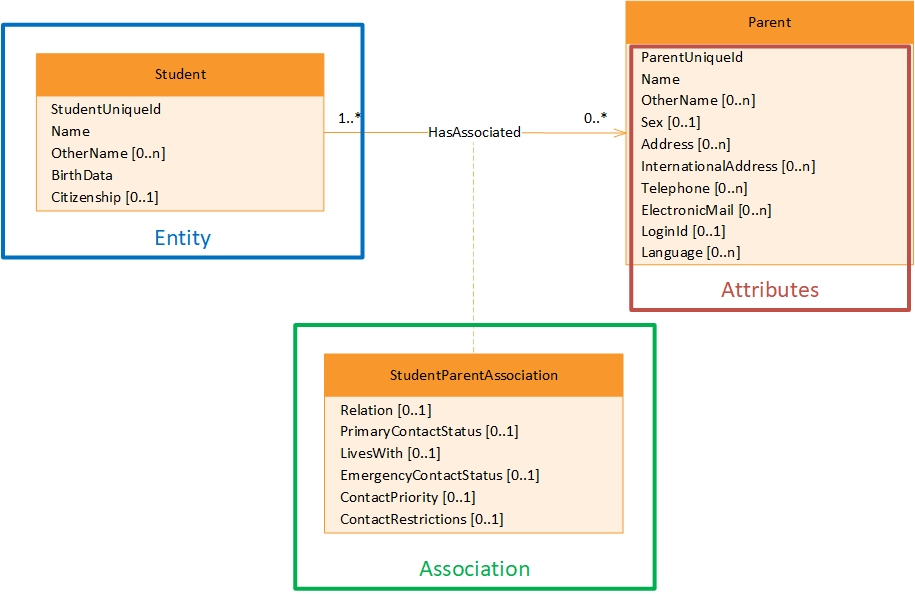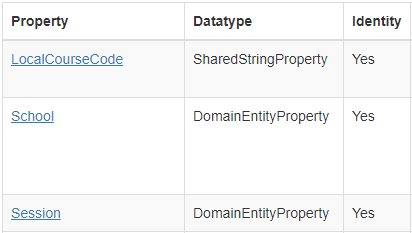This is the documentation for Ed-Fi Data Standard v3.2.0-c. This early access version of the standard powers supported products, including the ODS / API v5.0 and v5.1. This version was superseded by Ed-Fi Data Standard v3.2.
Core Concepts
The Ed-Fi Unifying Data Model (UDM) is an enterprise data model of commonly exchanged, shared, and analyzed K–12 education data. The model includes entities such as students, teachers, assessment results, attendance, and many others. Those entities contain attributes (i.e., properties) that are also easily recognized. For example, assessment results have things like scores, the date the assessment was taken, and accommodations. Entities have natural associations (i.e., relationships): for example, students are related to schools via their enrollments.

The Ed-Fi UDM is independent of any interchange mechanism, database or data warehouse storage structure. It is meant to capture the meaning and inherent structure of the most important information in the K–12 education enterprise in order to facilitate information sharing of education data.
The purpose of the Ed-Fi UDM is to enable information sharing and reuse of education data. The Ed-Fi UDM provides a standard means for:
- Data Description. Provides a uniform means to describe education data, its structure (syntax), and meaning (semantics), thereby supporting its discovery and sharing.
- Data Context. Facilitates discovery based upon the definition of specific education data domains.
- Data Sharing. Supports the access and exchange of data based upon bindings of subsets of the Ed-Fi UDM to specific structures and protocols that provide semantic interoperability between systems.
- Data Unification or “Harmonization." Provides the capability to compare education data artifacts across systems through a well-defined model that unifies the semantics of data artifacts into common entities.
As such, the Ed-Fi UDM forms the foundation for all Ed-Fi data standards and the products in the Ed-Fi Technical Suite.
Scope
The scope of the Ed-Fi UDM is K–12 education data relevant to schools, local education agencies, regional service education agencies, and state education agencies. The core goal of the Ed-Fi UDM is to capture "student-centric" information. That is, the data model is optimized to capture data directly relevant to decision-making as regards student performance. But, the data model has grown over time into related areas of the K–12 enterprise with important indirect relations to student achievement such as teacher professional development.
The Ed-Fi UDM focuses on granular education data for specific students, teachers, schools, courses, grades, assessments, and so forth. It generally does not include aggregate data but rather includes the fine-grained source data from which aggregate data may be calculated.
Ed-Fi Unifying Data Model Notation and Conventions
Unified Modeling Language Notation
The Ed-Fi UDM is expressed as Unified Modeling Language (UML) Class diagrams. UML Class diagrams capture the logical structure of a domain (in this case the education domain) as a set of entities, attributes, and associations between entities. More details can be found in the UDM Appendix A - UML Notation and Conventions.
Data Handbook
The Data Handbook accompanies the UML and completes the formal description of the UDM. The Data Handbook contains definitions of entities and other important information, such as entity keys. The Data Handbook also repeats various information from the UML notation, such as entity attributes and model structure.
Naming Conventions
The following naming conventions are used for the Ed-Fi Data Standard, and are consistent across Ed-Fi technical artifacts.
- Concatenated title case is used for entities, relationships, and attributes (e.g., “SchoolId”)
- Names use common terminology for the education industry
- Entity and attribute names generally align with those of CEDS
- Association names are formed as follows:
- Associations with attributes are named by concatenating the two entities they relate and ending with “Association”, e.g., “StudentSchoolAssociation”
- When there can be multiple associations between the same pair of entities, a semantic discriminator is added, e.g., StaffEducationOrganizationEmploymentAssociation, StaffEducationOrganizationAssignmentAssociation
Key Structure
To improve data quality and maximize the possibility for data to move between systems, Ed-Fi data models employ a natural key system. In the Ed-Fi UDM, this means one or more attributes that together define a unique record within an entity.
You can look up a key for any entity in the UDM Data Handbook (v3.2.0-c). Key attributes are indicated in the "Identity" column.

In the above example showing the Course Offering entity, the key is a Local Course Code, a School, and a Session. Collectively, these constitute the natural key.
Glossary of Terms
The following table is a general glossary of data modeling terms.
| Term | Definition |
|---|---|
| Entity | A classifier that describes a set of abstract or real objects that share the same features, constraints, and semantics. |
| Association | A relationship between entities which is used to show that instances of the entities could be linked to each other. |
| Attribute | A property that is owned by an entity. |